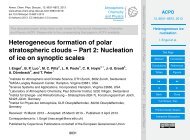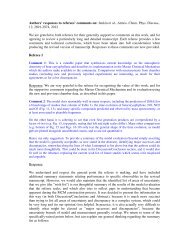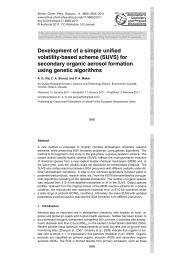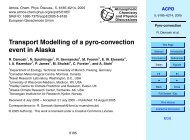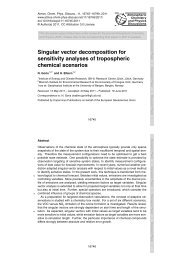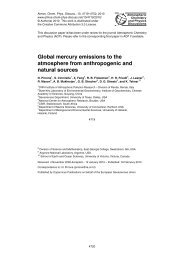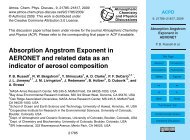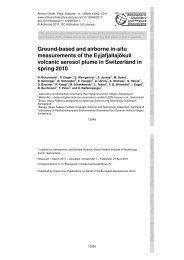SOA formation from the atmospheric oxidation of MBO - ACPD
SOA formation from the atmospheric oxidation of MBO - ACPD
SOA formation from the atmospheric oxidation of MBO - ACPD
You also want an ePaper? Increase the reach of your titles
YUMPU automatically turns print PDFs into web optimized ePapers that Google loves.
5<br />
10<br />
15<br />
20<br />
25<br />
mass spectra <strong>of</strong> BSTFA derivatives <strong>of</strong> compound 20, erythrose, and 2-methylglyceric<br />
acid (2-MGA) are similar, but each compound elutes at a different retention time and<br />
has a fragmentation pattern sufficiently different <strong>from</strong> compound 20 to distinguish <strong>the</strong><br />
individual compounds. This is readily seen <strong>from</strong> an examination <strong>of</strong> <strong>the</strong> mass spectrum<br />
<strong>of</strong> erythrose formed <strong>from</strong> <strong>the</strong> <strong>oxidation</strong> <strong>of</strong> 1,3-butadiene (Andove et al., 2006).<br />
The interpretation <strong>of</strong> <strong>the</strong> fragmentation patterns <strong>of</strong> <strong>the</strong> BSTFA derivative in EI and<br />
CI modes is shown in Scheme 1. Fragment ions at m/z 117, 131, 157, 205, 231,<br />
247, and 321 in Scheme 1 are postulated to come <strong>from</strong> loss <strong>of</strong> one or more groups<br />
including (-CH 3), (-TMSOH), (-(CH 3) 4Si), (−116 u), and (-TMSO). The base peak at<br />
m/z 131, for example, is possibly formed by a combined loss <strong>of</strong> (-TMSO) and (-116 u)<br />
groups <strong>from</strong> <strong>the</strong> molecular ion M + ; elimination <strong>of</strong> (-TMSO) leading to <strong>the</strong> <strong>formation</strong> <strong>of</strong><br />
a fragment at m/z 247. Thus, compound 20 has been tentatively identified as 2,3dihydroxyisopentanol<br />
(DHIP; see Table 2) also detected to a very minor degree in <strong>the</strong><br />
gas phase (Fig. 2).<br />
Figure 5 shows mass spectra in <strong>the</strong> EI (top) and CI (bottom) modes for two additional<br />
silylated compounds eluting at 25.5 and 26 min (Fig. 3, Peaks 42 and 46). The silylated<br />
derivative analyzed in CI mode shows fragments at m/z 437 (M +. −15), 319 (M +. −133),<br />
and 335 (M +. − 117), and generally weak adducts at M +. + 1, M +. + 29, and M +. + 41.<br />
Fragmentation patterns <strong>of</strong> <strong>the</strong> silylated compound are similar in CI and EI modes and<br />
are consistent with <strong>the</strong> presence <strong>of</strong> four -OH groups, with a derivative MW <strong>of</strong> 452. This<br />
compound was <strong>the</strong> most oxygenated product detected in <strong>MBO</strong> and tentatively identified<br />
as 2,3-dihydroxy-2-methylsuccinic acid (or isomers) with a compound MW <strong>of</strong> 164. This<br />
compound has been also detected in particle phase in field samples (Edney et al.,<br />
2003) and <strong>from</strong> <strong>the</strong> photo<strong>oxidation</strong> <strong>of</strong> toluene and 1,3,5-trimethylbenzene.<br />
Although 2-methylthreitol and 2-methylerythritol are found to originate <strong>from</strong> isoprene<br />
<strong>oxidation</strong>, <strong>the</strong>se compounds were also detected during <strong>the</strong> <strong>oxidation</strong> <strong>of</strong> <strong>MBO</strong> (Fig. 3;<br />
Peaks 36 and 38). However, 2-MGA, which is also seen in aerosol <strong>from</strong> isoprene photo<strong>oxidation</strong>,<br />
is just barely detectable above <strong>the</strong> chromatographic background and may<br />
have been formed <strong>from</strong> a slight isoprene impurity in <strong>the</strong> <strong>MBO</strong>. Given <strong>the</strong> extremely<br />
24060<br />
Discussion Paper | Discussion Paper | Discussion Paper | Discussion Paper |<br />
<strong>ACPD</strong><br />
11, 24043–24083, 2011<br />
<strong>SOA</strong> <strong>formation</strong> <strong>from</strong><br />
<strong>the</strong> <strong>atmospheric</strong><br />
<strong>oxidation</strong> <strong>of</strong> <strong>MBO</strong><br />
M. Jaoui et al.<br />
Title Page<br />
Abstract Introduction<br />
Conclusions References<br />
Tables Figures<br />
◭ ◮<br />
◭ ◮<br />
Back Close<br />
Full Screen / Esc<br />
Printer-friendly Version<br />
Interactive Discussion




